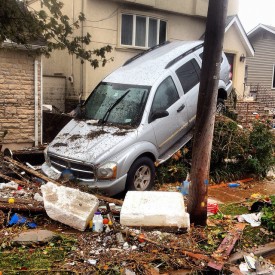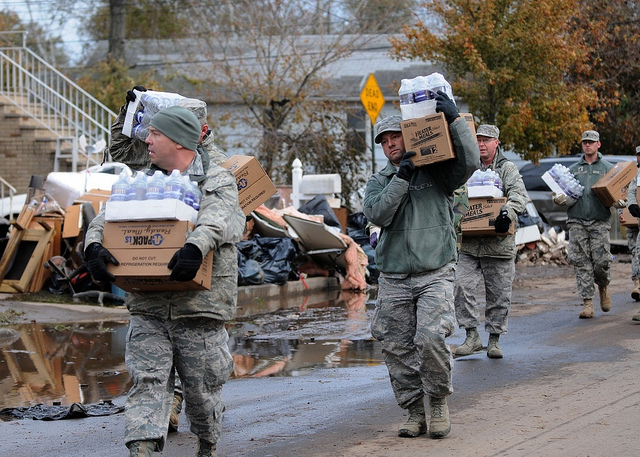What’s in a storm’s name(s)?
In hopes of avoiding a “Hurricane Cassandra” (yet another wake-up call that we simply ignore as Joe Romm fears) and moving us closer to a Cuyahoga—the name of the river in Ohio that caught fire in 1969 and set the stage for our major national environmental laws, I’m doing my part to pull something productive from the wreckage.
Seeking lessons for communicating about extreme weather in the context of climate change, I plumb the storm’s names and nicknames for useful and memorable takeaways.
Frankenstorm
It was days before Halloween and Hurricane Sandy was something of a hybrid—and thus arose the sensational, not-so-cute nickname Frankenstorm. But as KC Golden and others have pointed out, Frankenstorm, carries deeper meaning. Sandy, and any extreme weather event “juiced” by a warming climate, was part natural force, and part human-made creation.
In fact, the name Frankenstorm gives us a really simple way to remember how to talk about the climate science of extreme weather: In a climate warmed by emissions from burning fossil fuels, weather is now always part natural force and part man-made creation. What’s scary is that we are seeing weather extremes that are increasingly monstrous—more powerful, destructive, and deadly.

The basics of climate science are well-understood and should be underscored up front when discussing extreme weather: Climate change is happening, we are causing it, and it’s already impacting many kinds of weather in serious ways.
When it comes to storms like Sandy, there are climate factors that made it more dangerous to people and coastal communities. There are excellent primers on the science behind the storm here, here, here, and here.
Here’s the nutshell version from Forecast the Facts:
There are at least two specific ways greenhouse pollution made Hurricane Sandy into a monster. Hotter than normal sea surface temperatures in the Atlantic Ocean means heavier rainfall and stronger winds from Hurricane Sandy. Higher sea levels means increased coastal flooding, coastal erosion, and increased storm surges.
The gist is that if you warm the planet, you can expect more dangerous storms.
Bill Nye—true to form—says it in a way 3rd graders (and their parents too) can grasp: “Let’s be clear on the science. Climate change does not cause hurricanes and storms like Sandy… but climate change makes them worse—no question…Every scientist that I respect says that this will not only continue, but will continue to get worse, unless we stop pumping more and more greenhouse gases into the environment.”
Climate Central’s Andrew Freedman summed it up nicely too: “If [the climate science behind Sandy] were a criminal case, detectives would be treating global warming as a likely accomplice in the crime.”
The messaging takeaway here? Talk about extreme weather as part natural forces and part human-made monster due to a warming climate.
Sandy
The practice of giving first names to storms—Katrina, Isaac, Irene, Sandy—can wind up anthropomorphizing them, as if a storm has its own temperament or whims or personality.
But we’d be better served if we flipped that around, focusing on the victims and torn apart communities as people and places with familiar names. Looking at the devastation in New Jersey, this may be easiest for Springsteen fans for whom the name Sandy is ever associated with life on the boardwalk in Asbury Park. But for everybody else too, the name should be a reminder to talk about climate impacts in terms of people—people with families, kids, homes, neighborhoods, and livelihoods—and not just faraway lands, polar bears, faceless “future generations.”
And let’s talk about climate and energy policy solutions as the best ways for us to protect our families and quality of life.
Lesson: Put names and faces on climate impacts by talking about extreme weather as a threat to the people and places we hold dear.
Mega-storm
Sandy can be considered “mega” whether you’re measuring its swath, intensity, high-water mark, or rainfall, or if you’re counting casualties, families displaced, or power outages.
But one sobering measure of this storm’s impact will be the tally of the damages in dollars. Not to be cheeky, but we’re talking mega-bucks here.
As Bloomberg Businessweek underscored last week (See: It’s Global Warming, Stupid), one need only look to the insurance industry to get straightforward discussion of the threat of climate change and a picture of the cost—especially in North America:
On Oct. 17 the giant German reinsurance company Munich Re issued a prescient report titled Severe Weather in North America. Globally, the rate of extreme weather events is rising, and “nowhere in the world is the rising number of natural catastrophes more evident than in North America.” From 1980 through 2011, weather disasters caused losses totaling $1.06 trillion. Munich Re found “a nearly quintupled number of weather-related loss events in North America for the past three decades.” By contrast, there was “an increase factor of 4 in Asia, 2.5 in Africa, 2 in Europe, and 1.5 in South America.” Human-caused climate change “is believed to contribute to this trend,” the report said, “though it influences various perils in different ways.”
Global warming “particularly affects formation of heat waves, droughts, intense precipitation events, and in the long run most probably also tropical cyclone intensity,” Munich Re said.
(Emphasis mine. See the press release from Munich Re here. See also, this report by Ceres on climate costs for insurers.)
Sandy is estimated to cost around $50 billion. Indeed, the expense of extreme weather is becoming staggering. Tina Rosenberg, in the New York Times, tries to get a handle on it:
Every year, ISO Property Claim Services, which does research and risk consulting for property and casualty insurers, measures insured losses in the United States due to natural catastrophes. Last year the figure was $32 billion. This year Sandy alone may cost $50 billion — not to mention damage caused by record heat, record drought and record wildfires. And “insured losses” covers property and casualty insurance only. It doesn’t include crop insurance — this year about a $20 billion to $25 billion loss, and taxpayers will cover all but $5 billion of that. It doesn’t include payouts by the national flood insurance program — at least $1 billion this year even before Hurricane Sandy.
And of course, it doesn’t include the expense of replacing destroyed tunnels, bridges, subways and coastal defenses. Nor the costs of cleanup, business interruption (the largest loss component of 9/11), or higher prices — drought is a big reason we are paying more for food and cotton clothing. Nor the soaring price of insurance.
Lesson: Since it’s generally acknowledged that money talks, we should talk about the money—and we’re already paying for climate change.
Hurricane Exxon
For his part, Bill McKibbon says that if there were any poetic justice, the storm would be named Hurricane Chevron or Hurricane Exxon. “These fossil fuel corporations are driving the climate crisis and spending millions to block solutions,” he writes. He goes on:
The fossil fuel industry has spent over $150 million to influence this year’s election. Last week, Chevron made the single biggest corporate political donation since the Citizens United decision. This industry warps our democracy just as it pollutes our atmosphere. And we’ve had enough.
…In the coming year, we’re going to fight both forms of this pollution.
These nicknames haven’t caught on outside climate change policy circles, but there’s an important reminder here for communicators. Fossil fuel companies are blocking progress on climate and energy policy. They have confused the public with expensive and sophisticated anti-science disinformation campaigns.
At the same time that they’re making record profits (and producing less oil), we are still subsidizing them. “In 2012 the Congressional Joint Committee on Taxation estimated that these big five oil companies would receive $2.4 billion in special tax breaks.” (See Climate Progress for more on Big Oil’s profits and just how much of their $90 billion in profits they spent on lobbying and campaign contributions in 2012.)
We need to go after the climate “villains” who have a stranglehold on progress.
Lesson: Hurricane Sandy is a reminder to talk about how Big Oil and coal companies are blocking American clean energy solutions, spending millions to rig the system and protect their profits.
Here’s the Flashcard version:
[flashcard]
Talking Climate: Lessons from Sandy
Frankenstorm: Talk about extreme weather like Sandy as part natural forces and part human-made monster due to a warming climate.
Sandy: Put names and faces on climate impacts by talking about extreme weather as a threat to the people and places we hold dear.
Mega-storm: Since money talks, we should talk about the money—and we’re already paying mega-bucks for climate change.
Hurricane Exxon: Talk about how Big Oil and coal companies are blocking American clean energy solutions, spending millions to rig the system and protect their profits.
[/flashcard]
These are meant to be simple, memorable ways to talk about Sandy and other extreme weather events amplified by signals from a warming climate. And while tragedies like Sandy serve as bleak wake up calls, we should balance the sad news about impacts with messages about solutions that are ready to go, tapping into people’s sense of patriotism and pride. We can rise to the challenge and succeed. We have the technology, the know-how, and the workforce. Nothing should stand in our way.
So, aside from immediate assistance for families, what can we do right away in response to Sandy? The storm’s timing before US elections makes clear that candidates and electeds require more pressure to take climate change seriously—including demanding accountability for oil and coal companies. Overnight, Sandy forced the media and politicians to talk about climate. Now’s the time to keep up sustained pressure on our representatives to get to work and on our favorite news outlets and weather forecasters, demanding full and accurate coverage of extreme weather and climate solutions.


Comments are closed.